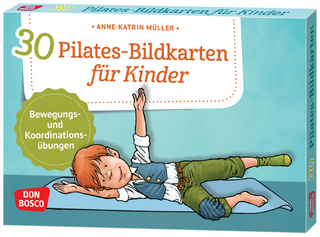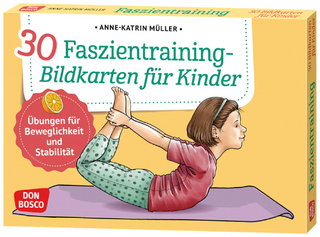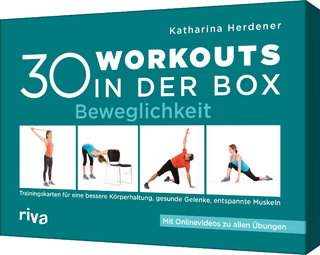
Senior Fitness Test Software 2.0 and Manual Package Subscription
Human Kinetics
978-1-4504-3203-0 (ISBN)
- Titel ist leider vergriffen;
keine Neuauflage - Artikel merken
The Senior Fitness Test Software 2.0 and Manual Package Subscription offers a comprehensive method of assessing the physical attributes that older adults need in order to perform daily activities. Consisting of the Senior Fitness Test Manual, Second Edition (with bound-in DVD), and a one-year subscription to the Senior Fitness Test Software 2.0 (accessiblefrom internet-enabled devices, including smart phones and tablets), this kit helps health practitioners and fitness and rehabilitation specialists identify weaknesses that cause mobility problems, develop exercise programs to improve functional fitness, prevent future mobility issues, and evaluate progress.
The Senior Fitness Test Manual, Second Edition, provides thorough coverage of the seven tests that make up the Senior Fitness Test (SFT)--lower- and upper-body strength, aerobic endurance, lower- and upper-body flexibility, agility, and balance. Each test can be conducted with minimal space, equipment, and technical requirements, making it easy to administer in most clinical and community settings or in the home environment. The manual contains instructions on preparing and administering the tests and interpreting and using test results. Readers will find guidelines on creating senior fitness programs as well as exercises to recommend for improving functional fitness scores.
The second edition of the Senior Fitness Test Manual offers new tools to help facilitate the Senior Fitness Test. It includes expanded information on ways to modify test protocols for older adults with limiting conditions such as osteoporosis, obesity, Alzheimer's disease, diabetes, stroke, fibromyalgia, heart conditions, multiple sclerosis, hip and knee replacements, chronic renal failure, chronic obstructive pulmonary disease, osteoarthritis, and blindness or low vision. Ready-to-use materials such as reproducible forms, large-print instructions--complete with photos--to post at testing stations, and large versions of performance charts make the testing process more effective. An expanded chapter on improving test scores includes illustrated instructions for exercises that can be prescribed to seniors to help them improve their fitness.
The manual retains national normative data based on age and sex for more than 7,000 adults ages 60 to 94, but it now also includes criterion-referenced, clinically relevant fitness standards. Based on the authors' continued groundbreaking research on aging and functional fitness, these new criterion-referenced standards allow practitioners and older adults to identify the test scores at a specific age that are correlated with maintaining functional mobility into the 90s, providing a new and deeper understanding of the test scores. This allows practitioners and their clients to focus on maintaining or improving functional fitness with customized goals meant to preserve and improve individual abilities.
The second edition of the Senior Fitness Test Manual is packaged with a DVD that contains visual demonstrations of the tests, including setup, execution, evaluation, and modifications to testing protocols to accommodate clients' limitations. Throughout the text, DVD icons indicate when to view the DVD for live demonstrations.
Once the Senior Fitness Test is conducted, the test results for all participants can be entered into the Senior Fitness Test Software 2.0. This web application can be used in analyzing test scores, creating individual or aggregated reports, and generating program outcome statistics. Participants can be grouped according to specifications such as age and sex or characteristics such as smoker and nonsmoker.
Roberta E. Rikli, PhD, is professor of kinesiology and dean emeritus of the college of health and human development at California State University in Fullerton and was cofounder of the LifeSpan Wellness Program at Fullerton. For the past two decades she has done extensive work in physical performance assessment with a particular focus on senior fitness. She has published numerous scientific papers on her work and has made over 100 presentations at conferences and workshops in the United States, Canada, Germany, France, Finland, Scotland, Brazil, China, Korea, and Japan. Dr. Rikli has served on the editorial boards of three scientific journals and is a regular reviewer for several others. She has held leadership positions in professional organizations, including the International Society for Aging and Physical Activity; the American Alliance for Health, Physical Education, Recreation and Dance (AAHPERD); the American Kinesiology Association; and the National Academy of Kinesiology. Dr. Rikli lives in Orange, California, and enjoys playing golf, hiking, and playing tennis. C. Jessie Jones, PhD, is professor and chair of the department of health science at California State University in Fullerton. She is director of the Fibromyalgia and Pain Management Center at Fullerton and cofounder of the Center for Successful Aging. Dr. Jones is internationally known for her research, program design, curriculum development, and instructor training in the field of exercise science and aging. She has taught senior fitness classes and conducted training workshops for senior fitness instructors for over 25 years. Her work has been covered in numerous publications and presented at conferences worldwide. Her professional memberships include the Gerontological Society of America, the American Public Health Association, and the American Academy for Pain Management. Dr. Jones lives in Fullerton, California, where she enjoys dancing, drumming, hiking, playing golf, and jogging with her dog.
Chapter 1. Fitness Testing in Later Years: Recognizing Unique Needs of Older Adults Importance of Fitness and Fitness Testing in Later Years Rationale for Developing the SFT Unique Qualities of the SFT Uses of the SFT History of the SFT-A Decade of Use Summary Chapter 2. The Senior Fitness Test: Defining Functional Fitness Parameters Conceptual Background Functional Fitness Parameters Test Selection Criteria Overview of Test Items Summary Chapter 3. Test Validity, Reliability, Percentile Norms, and Criterion-Referenced Performance Standards: Identifying Relevant Fitness Measures for Older Adults Validity Reliability Percentile norms Criterion-referenced functional fitness standards Summary Chapter 4. Test Administration: Establishing Consistent Testing Protocols Pretest Procedures and Considerations Administering the Tests Guidelines for Group Testing Summary Chapter 5. Test Results: Interpreting and Using Feedback to Motivate and Improve Performance Interpreting Test Scores Methods of Providing Feedback to Participants
| Erscheint lt. Verlag | 15.11.2012 |
|---|---|
| Verlagsort | Champaign, IL |
| Sprache | englisch |
| Gewicht | 658 g |
| Themenwelt | Sachbuch/Ratgeber ► Gesundheit / Leben / Psychologie |
| Sachbuch/Ratgeber ► Sport ► Fitness / Aerobic / Bodybuilding | |
| Medizin / Pharmazie | |
| ISBN-10 | 1-4504-3203-4 / 1450432034 |
| ISBN-13 | 978-1-4504-3203-0 / 9781450432030 |
| Zustand | Neuware |
| Haben Sie eine Frage zum Produkt? |
aus dem Bereich


